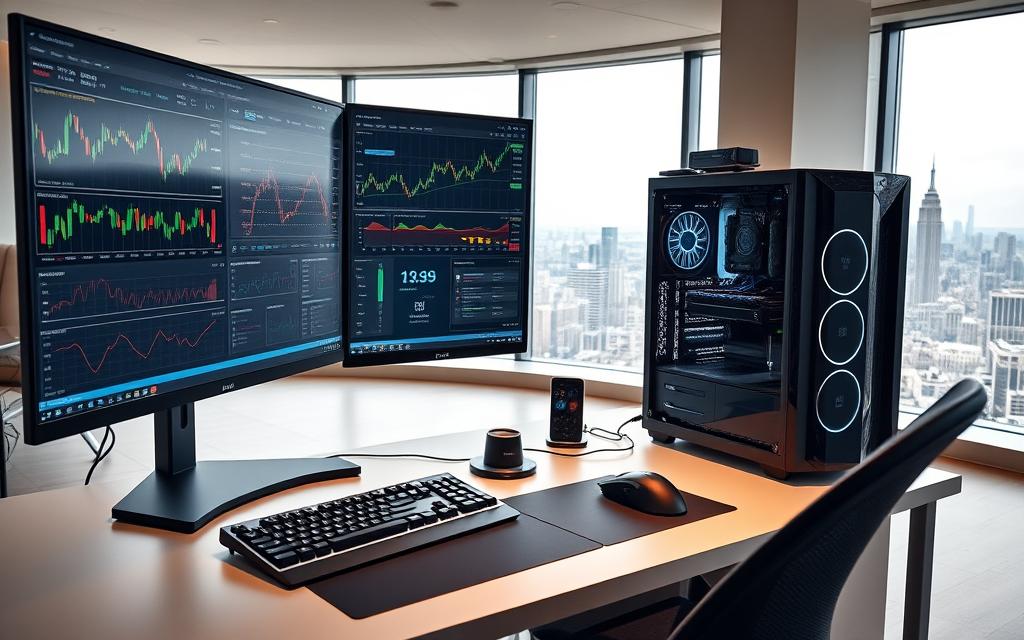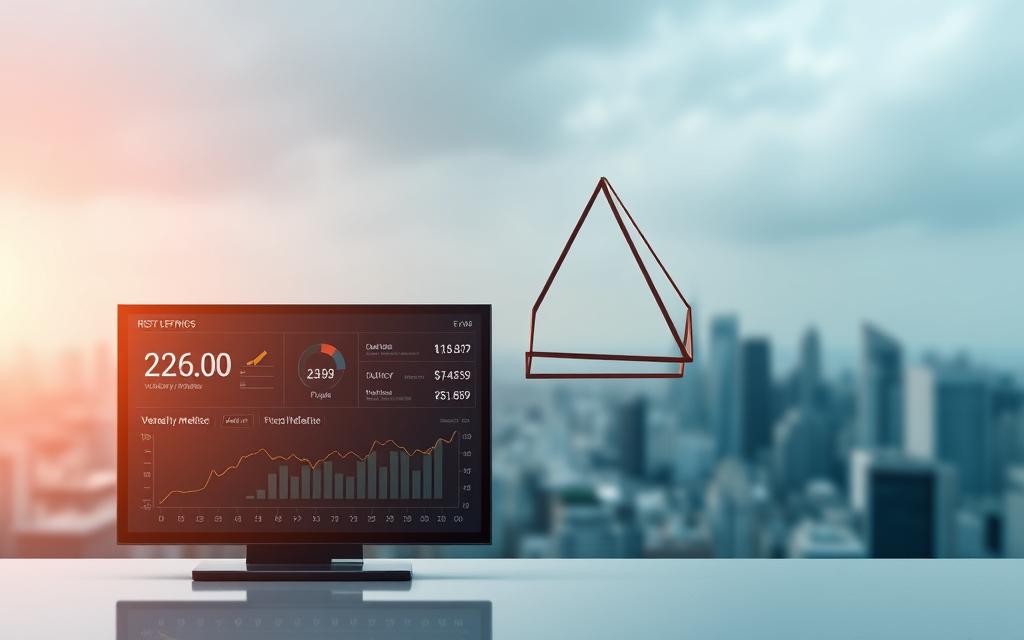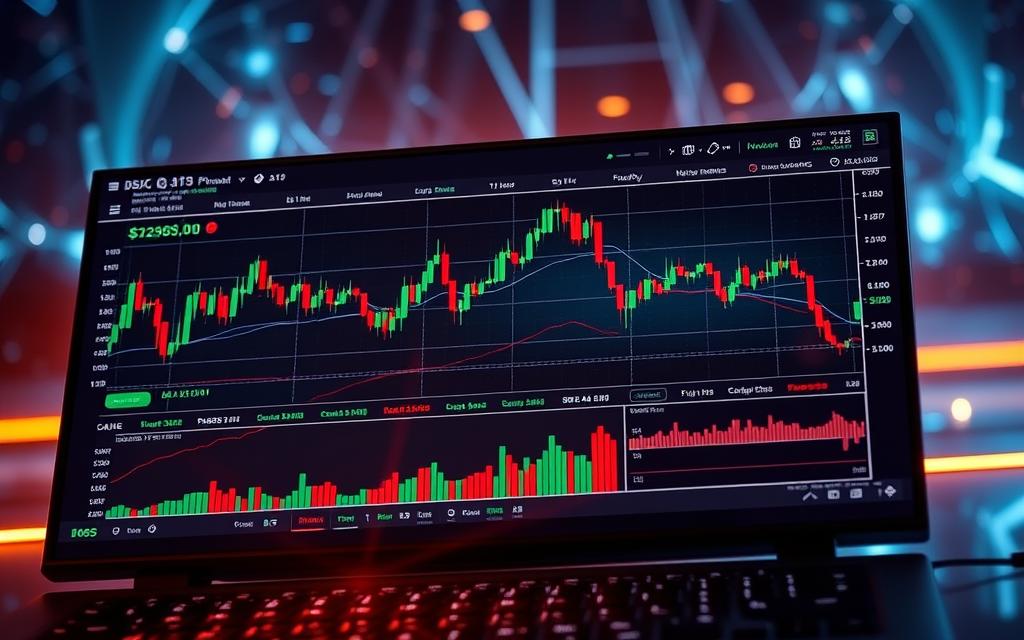Table of Contents
The digital asset market offers unique opportunities for those looking to capitalize on short-term price movements. Unlike traditional stock exchanges, cryptocurrency markets operate 24/7, allowing for continuous trading without time restrictions.
Volatility defines this space—Bitcoin, for example, saw a 73% drop in 2018 but rebounded with a 156% gain in 2023. Such swings create potential for profit but also carry significant risk.
Platforms like Gemini and Binance provide accessible entry points for beginners. However, success requires strategy, discipline, and an understanding of market behavior. The feasibility depends on risk tolerance and market knowledge.
What Is Day Trading Cryptocurrency?
Unlike stocks, digital assets trade around the clock, creating distinct opportunities for active participants. This approach involves buying and selling coins within short timeframes—often minutes or hours—to profit from price movements.
Definition and Basics
Blockchain technology underpins every transaction, ensuring peer-to-peer verification without banks. Traders either own coins outright or use derivatives like CFDs (Contracts for Difference), which let them speculate without holding assets. For example, platforms like IG Group offer CFD options.
How It Differs from Traditional Markets
Traditional exchanges like the NYSE close at 4 PM ET, but crypto markets never sleep. This 24/7 access demands constant vigilance. Order types also vary:
- Market orders: Execute instantly at current prices.
- Limit orders: Set specific buy/sell thresholds.
Essential tools like exchange accounts (Binance, Coinbase), secure wallets, and charting software (TradingView) streamline the trading journey.
“Crypto’s volatility isn’t a bug—it’s a feature. Traders must adapt or get left behind.”
Can You Day Trade Crypto? Understanding the Feasibility
Navigating cryptocurrency markets requires understanding liquidity and volatility dynamics. While the 24/7 nature of these markets offers flexibility, it also demands constant attention to price movements and order execution.

Market Hours and Liquidity
Major coins like Bitcoin and Ethereum dominate trading volumes, but altcoins often face liquidity gaps. For example, Bitcoin Cash/ETH pairs exhibit 8-point spreads, increasing transaction costs. Slippage becomes a significant risk during high-volatility events, where orders fill at unintended prices.
| Asset | Annualized Volatility (2023) | Average Daily Spread |
|---|---|---|
| Bitcoin (BTC) | 75% | 0.1% |
| S&P 500 | 18% | 0.02% |
Volatility as a Double-Edged Sword
Crypto’s wild swings dwarf traditional assets—BTC’s volatility is 4x higher than the S&P 500. Traders capitalize on these trends through arbitrage, exploiting price differences across exchanges like Binance and Kraken. Tools like IG’s Crypto 10 index help track top assets by market cap, offering a macro view.
“Liquidity determines execution quality, but volatility defines profit potential—master both to thrive.”
How Much Can a Crypto Day Trader Make?
Earnings potential in digital asset markets varies widely based on strategy and market conditions. While some generate steady profits, others face steep losses from volatility or poor timing. Success hinges on risk management, fee structures, and tax efficiency.
Factors Influencing Profitability
Professional traders typically risk 1–2% of capital per trade. For example, a $10,000 account might allocate $100–$200 per Ethereum CFD position ($1/point movement). Key variables include:
- Platform fees: Binance.US charges 0.1% spot fees, while Coinbase’s spread can exceed 0.5%.
- ROI strategies: Scalping targets 0.5–1% daily gains, whereas swing trading aims for 5–10% weekly.
- Tax rules: The IRS treats crypto as property—wash sale rules don’t apply, but Form 1099 reports are mandatory.
Realistic Earnings Expectations
Margins shrink after accounting for 50% collateral requirements on ETH CFDs and slippage during high volatility. A trader netting 3% monthly could yield $3,600 annually on a $10,000 account—before taxes and fees.
“The top 10% of traders consistently outperform by combining technical analysis with strict stop-losses.”
Platforms like TradingView offer tools to track trends, but sustained success requires adapting to shifting opportunities. Most importantly, avoid overleveraging—even seasoned professionals cap positions at 5% of total capital.
Essential Tools for Day Trading Cryptocurrency
Professional traders rely on specialized platforms and analytical tools to gain an edge. The right setup combines robust exchange access with real-time data visualization, enabling precise decision-making in fast-moving markets.

Exchanges and Trading Platforms
Centralized exchanges (CEX) like Coinbase offer user-friendly interfaces and high liquidity, while decentralized platforms (DEX) such as Uniswap provide peer-to-peer trading without intermediaries. Key considerations include:
- Security: Look for 2FA, cold storage, and insurance against breaches.
- Compliance: FINRA-regulated platforms like Gemini ensure adherence to U.S. laws.
- API access: Automate strategies using interfaces that connect to trading bots.
Technical Analysis Software
Interactive charts on TradingView or IG’s HTML5 platform (covering 13,000+ markets) help identify trends and patterns. Essential indicators like moving averages flag potential reversals in asset prices.
“A trader’s toolkit is only as strong as its weakest link—prioritize reliability over flashy features.”
Platform-native tools, such as Gemini’s volatility alerts, complement third-party solutions. The goal? Streamline workflows while minimizing execution delays during critical moments.
Key Strategies for Successful Crypto Day Trading
Mastering short-term digital asset strategies demands precision and adaptability. Each approach requires unique tools and mindset adjustments to capitalize on fleeting price movements.
Scalping and High-Frequency Trading
Scalpers thrive on 1-minute charts, exploiting micro-fluctuations. Bollinger Bands pinpoint entry points when volatility contracts. Essential requirements include:
- Low-latency platforms: Execution delays above 50ms erode profits.
- Tight spreads: Assets like BTC/USD on Binance offer 0.1% fees ideal for rapid trades.
- Volume analysis: Breakouts above 20% average volume confirm momentum.
Trend Following and Range Trading
Fibonacci retracement levels (38.2%, 61.8%) identify pullbacks during uptrends. Compare EMA (9-period) and SMA (21-period) crossovers:
- EMA: Reacts faster to recent price changes.
- SMA: Smoothens noise for broader trends.
Range-bound markets reward limit orders at support/resistance levels. Patience is critical—wait for confirmation candlesticks.
“A trader’s edge lies in consistency, not heroic single trades.”
Psychological resilience separates winners. Rapid decisions under pressure require pre-defined rules. Backtest strategies across time frames to validate reliability.
Risk Management in Crypto Day Trading
Effective risk control separates successful traders from those facing steep losses. Volatile markets demand structured strategies to protect capital while maximizing opportunities. Tools like stop-loss orders and disciplined position sizing are non-negotiable.

Stop-Loss and Take-Profit Orders
Guaranteed stops, like IG’s 0.15% fee option, prevent slippage during extreme volatility. Compare stop types:
- Trailing stops: Adjust dynamically with price movements, locking in profits.
- Static stops: Fixed exit levels, ideal for predefined risk tolerance.
Take-profit orders secure gains when assets hit target prices. For ETH CFDs, setting these levels avoids emotional decision-making during spikes.
Position Sizing and Capital Preservation
The 2% rule limits exposure per trade—a $50,000 portfolio risks $1,000 per position. Additional safeguards:
- Diversification: Spread allocations across sectors (DeFi, NFTs) to reduce systemic risk.
- Leverage caution: Margin calls trigger at 50% collateral—overleveraging amplifies losses.
- Negative balance protection: Platforms like Kraken prevent accounts from going below zero.
“Survival in crypto hinges on preserving capital first, profiting second.”
Backtest strategies using historical data to validate risk-reward ratios. Adapt to shifting market conditions without compromising core rules.
Best Technical Indicators for Day Trading Crypto
Technical analysis transforms raw price data into actionable insights for short-term traders. Mathematical tools filter noise, highlighting high-probability opportunities. Mastering these indicators sharpens decision-making in volatile conditions.

Relative Strength Index (RSI)
RSI measures overbought (70+) or oversold (30-) conditions. Crypto markets often test extremes, making 25-period settings more effective than traditional 14-period. For example, ETH/USD showed a 12% rebound after RSI dipped below 25 in March 2023.
- Divergence signals: Price makes higher highs while RSI declines—potential reversal ahead.
- Confirmation rule: Pair RSI breaks with volume spikes for higher accuracy.
Moving Averages and MACD
MACD histograms track momentum shifts. A crossover above the signal line confirms bullish trends. Combined with 50-day and 200-day moving averages, traders spot key support points.
| Indicator | Optimal Use Case | BTC Example (2023) |
|---|---|---|
| MACD | Trend confirmation | Bullish crossover preceded 22% rally |
| EMA (9-day) | Short-term entries | Bounce off EMA yielded 8% gain |
“Indicators are compasses, not maps—context determines their true value.”
Backtest strategies against historical BTC data to validate reliability. Limit tools to three per setup—overloading clouds judgment. Consistency beats complexity in fast-moving markets.
Choosing the Right Cryptocurrencies to Trade
Selecting digital assets requires balancing risk tolerance with profit potential. Bitcoin’s 50%+ market dominance influences broader trends, while stablecoins like USDT handle $130B daily volume. Traders must evaluate liquidity, volatility, and regulatory risks.
High-Volatility vs. Stable Coins
Assets like Bitcoin and Ethereum swing 5–10% daily, creating profit opportunities but demanding strict stop-losses. Stablecoins (USDC, USDT) anchor portfolios during downturns. Key differences:
- Volatility: BTC’s 75% annualized swings vs. USDT’s
- Use cases: Hedging vs. rapid trades.
- Regulatory scrutiny: Privacy coins face delisting risks on major exchange platforms.
Liquidity and Market Cap Considerations
Large-cap coins (top 10 by market cap) ensure smoother trade execution. Memecoins like Dogecoin often spike on social hype but lack fundamentals. Compare liquidity pools across exchanges:
| Asset | Market Cap | 24h Volume |
|---|---|---|
| Bitcoin (BTC) | $600B | $20B |
| Tether (USDT) | $83B | $50B |
“Altcoin seasons follow Bitcoin’s dominance cycles—track BTC’s prices to time entries.”
Tools like CoinMarketCap filter assets by volume, ensuring trades execute at intended prices. Diversify across sectors (DeFi, Layer 1s) to mitigate systemic risks.
Legal and Tax Implications of Day Trading Crypto
The IRS treats cryptocurrencies differently than traditional investments, creating unique reporting challenges. Since 2014, IRS Notice 2014-21 classifies digital assets as property, triggering capital gains taxes on each taxable event.
Regulatory Compliance in the U.S.
The SEC aggressively targets unregistered platforms, as seen in the FTX case. Traders must verify exchange compliance with:
- FINRA: Registered platforms like Gemini adhere to investor protection rules.
- State laws: Texas exempts crypto from securities laws, while New York mandates BitLicense.
Tax Reporting and Record-Keeping
Form 8949 details every transaction—failure to report incurs penalties. Key considerations:
| State | Crypto Tax Treatment | Reporting Threshold |
|---|---|---|
| Texas | No state income tax | N/A |
| New York | Capital gains + 8.82% tax | $1M+ annual volume |
*Wash sale rules* don’t apply, but traders still track losses to offset profits. Tools like CoinTracker automate IRS forms and fee calculations.
“Accurate records turn tax season from a headache into a strategic advantage.”
Conclusion: Is Day Trading Crypto Worth It?
Active participation in volatile markets isn’t for everyone. Data shows 80% quit within two years, while the top 5% capture 90% of profits. Weighing time investment against potential returns is critical.
Psychological resilience separates winners from the rest. Rapid decisions under pressure require discipline. Passive alternatives like Bitcoin ETFs (BITO: 0.95% fee) offer lower-risk exposure.
Continuous education sharpens strategies. Charts, news, and regulatory updates shape the trading journey. Before starting, assess:
- Capital tolerance for 10%+ daily swings
- Availability for 24/7 market monitoring
- Understanding of tax implications
Mastery demands patience. Start small, scale wisely.
FAQ
What is day trading cryptocurrency?
Day trading cryptocurrency involves buying and selling digital assets within the same day to profit from short-term price movements. Unlike long-term investing, traders capitalize on market volatility using technical analysis and real-time data.
How does crypto day trading differ from traditional markets?
Cryptocurrency markets operate 24/7, unlike stock exchanges with fixed hours. The extreme volatility in crypto offers more frequent opportunities but also higher risk compared to traditional assets like stocks or forex.
What are the best tools for crypto day trading?
Reliable exchanges like Binance or Coinbase Pro, charting platforms such as TradingView, and technical indicators like RSI or MACD are essential. Stop-loss orders and portfolio trackers help manage risk effectively.
How much can a crypto day trader realistically earn?
Earnings vary based on strategy, capital, and market conditions. While some traders achieve consistent profits, others face losses due to high volatility. Proper risk management is crucial to sustaining long-term gains.
What strategies work best for crypto day trading?
Scalping, trend following, and range trading are popular methods. Scalpers target small price gaps, while trend traders ride momentum. Each strategy requires discipline and strict exit rules to lock in profits.
How important is risk management in crypto trading?
Critical. Using stop-loss orders, diversifying trades, and limiting position sizes prevent catastrophic losses. Emotional control and predefined risk-reward ratios improve decision-making during volatile price swings.
Which cryptocurrencies are best for day trading?
High-liquidity coins like Bitcoin (BTC) and Ethereum (ETH) reduce slippage. Altcoins with strong volatility, such as Solana (SOL) or Cardano (ADA), may offer higher rewards but come with increased risk.
Are there legal considerations for crypto day traders?
Yes. In the U.S., profits are taxable as income or capital gains. Traders must comply with IRS reporting requirements and maintain records of all transactions for accurate tax filings.









